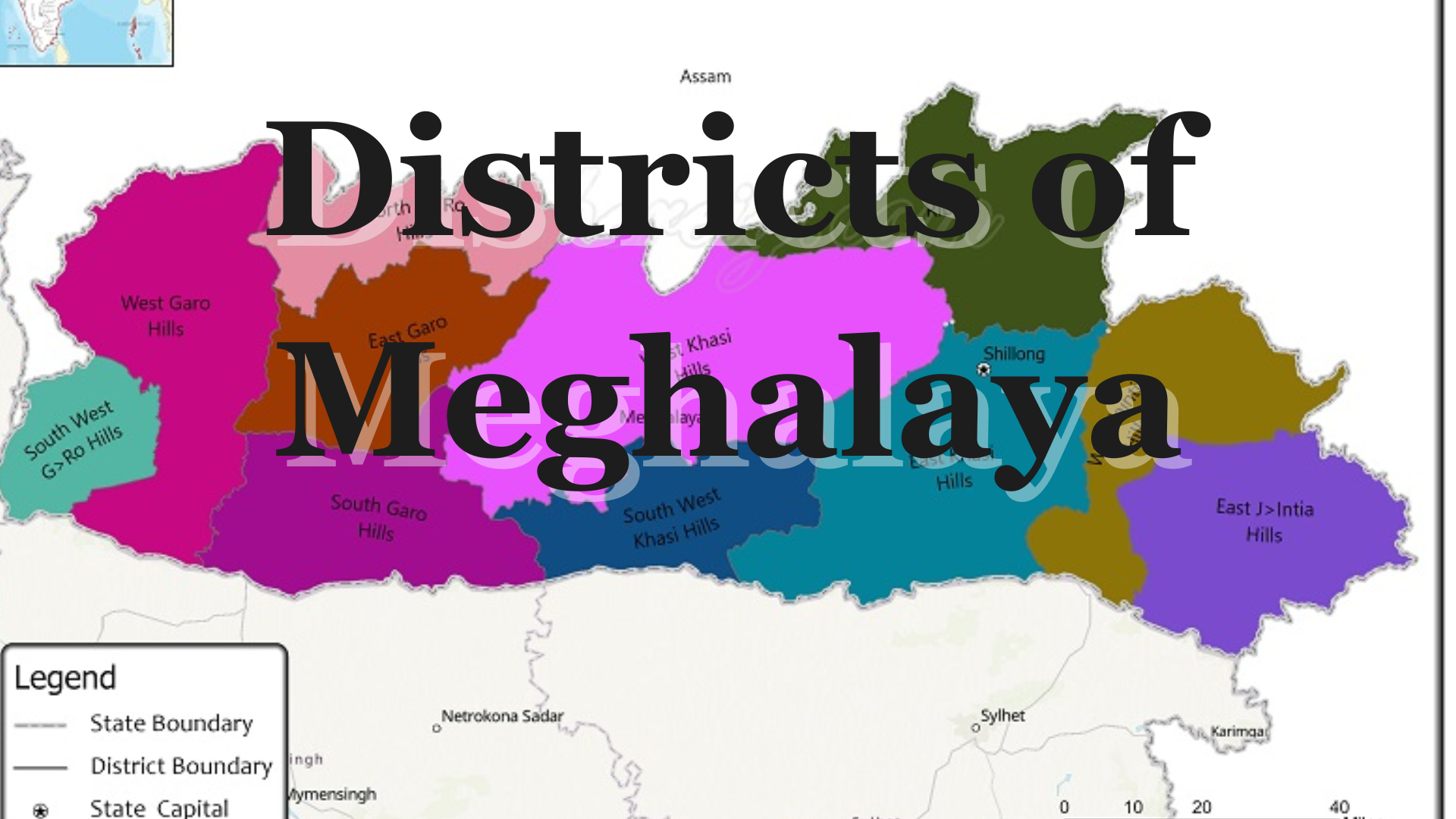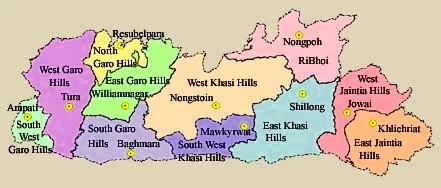

Districts of Meghalaya : Meghalaya is made up of 12 districts, each overseen by officials like District Magistrates or Commissioners, who collaborate with Superintendents of Police to maintain law and order. Initially, when Meghalaya became a separate state from Assam in 1972, it had only two districts: United Khasi Hills & Jaintia Hills and Garo Hills.
Over time, the number of districts has increased to 12, reflecting the state's evolving administrative structure. For further information regarding the Districts of Meghalaya, candidates should go through the below article.
Districts of Meghalaya
Meghalaya, which became an independent state on January 21, 1972, broke away from its ancient ties with Assam to carve out a distinct identity in India's northeastern area. Meghalaya, which has a total area of 22,429 square kilometres, is split administratively into 12 districts, which are then further divided into three divisions.List of Districts of Meghalaya
The entire list of Meghalaya districts is provided here. Examine the names of each of the state's twelve districts, together with details about each one's covered territory and population total. See the table below for a comprehensive analysis of the List of Districts of Meghalaya.| List of Districts of Meghalaya | ||||
| District | Headquarters | Area (km²) | Population (2011) | Established |
| North Garo Hills | Resubelpara | 1,113 | 118,325 | 2012 |
| East Garo Hills | Williamnagar | 1,490 | 199,592 | 1976 |
| South Garo Hills | Baghmara | 1,850 | 142,334 | 1992 |
| West Garo Hills | Tura | 2,855 | 472,497 | 1976 |
| South West Garo Hills | Ampati | 822 | 172,495 | 2012 |
| West Jaintia Hills | Jowai | 1,693 | 270,352 | 2012 |
| East Jaintia Hills | Khliehriat | 2,040 | 122,939 | 2012 |
| East Khasi Hills | Shillong | 2,752 | 825,922 | 1976 |
| West Khasi Hills | Nongstoin | 3,890 | 252,010 | 1976 |
| South West Khasi Hills | Mawkyrwat | 1,341 | 110,152 | 2012 |
| Eastern West Khasi Hills | Mairang | 1,356.77 | 131,451 | 2021 |
| Ri-Bhoi | Nongpoh | 2,378 | 258,840 | 1992 |
Districts of Meghalaya Administrative Division
Here, we've included details regarding Meghalaya's division system, which separates the state into districts and administrative divisions. See which districts in Meghalaya are part of the Khasi Hills, Garo Hills, and Jaintia Hills divisions by looking at the table below.| Districts of Meghalaya Administrative Division | |
| Divisions | Districts of Meghalaya |
| Khasi Hills | Ri-Bhoi |
| East Khasi Hills | |
| West Khasi Hills | |
| South West Khasi Hills | |
| Eastern West Khasi Hills | |
| Garo Hills | North Garo Hills |
| South Garo Hills | |
| East Garo Hills | |
| West Garo Hills | |
| South West Garo Hills | |
| Jaintia Hills | East Jaintia Hills |
| West Jaintia Hills | |
Districts of Meghalaya Importance
The districts of Meghalaya have a variety of functions, including cultural centres, epicentres of education, administrative hubs, and drivers of the state's economic development. Each district adds a special flavour to Meghalaya's vibrant and diverse landscape. Thus, candidates can go through the Districts of Meghalaya Importance from the below table:-| Districts of Meghalaya Importance | |
| District | Importance |
| Ri-Bhoi | Connecting Hub: Plays a key role in connecting different regions. |
| East Khasi Hills | Administrative Hub: Houses the capital, Shillong, and is the heart of governance. |
| West Khasi Hills | Cultural Richness: Enriched with diverse cultures and traditions. |
| South West Khasi Hills | Scenic Beauty: Known for picturesque landscapes, adding to the state's beauty. |
| Eastern West Khasi Hills | Agricultural Hub: Significant for agriculture, contributing to food production. |
| North Garo Hills | Biodiversity: Abundant flora and fauna, enhancing the state's ecological diversity. |
| South Garo Hills | Cultural Diversity: Home to various ethnic communities, showcasing Meghalaya's culture. |
| East Garo Hills | Educational Excellence: Hosts educational institutions, fostering learning. |
| West Garo Hills | Economic Center: Significant for trade and commerce, boosting economic development. |
| South West Garo Hills | Natural Resources: Abundance of resources supporting local industries. |
| East Jaintia Hills | Industrial Growth: Home to industrial zones, contributing to economic vibrancy. |
| West Jaintia Hills | Historical Significance: Rich in historical landmarks, preserving Meghalaya's heritage. |
Largest Districts of Meghalaya
West Garo Hills, situated in the western region of Meghalaya, is known for its expansive landscapes and its contribution to the region's economic development. It's one of the biggest districts around, and it does a lot to help businesses and trade grow, making things better for everyone. The area is made up of a variety of environments, including hills with slopes and lush fields.Smallest Districts of Meghalaya
South West Khasi Hills, Meghalaya's hidden jewel, is one of the state's smallest districts, but for good cause. Despite its small size, South West Khasi Hills is important to Meghalaya since it offers a distinct charm to the state's diversified culture. Despite their smaller numbers, the people here have a significant influence on Meghalaya's diverse cultural landscape.Districts of Meghalaya Map
Examine the map provided here to find the geographical locations of each of the Meghalaya districts. The proportional sizes of the state's districts will also be made clear by this visual help. To improve the candidate's comprehension of the locations and sizes of the districts in Meghalaya State, view the image for the most recent list of districts of Meghalaya.
MGNREGA West Garo Hills
The MGNREGA scheme in West Garo Hills district is very helpful for local villagers who need work. With this scheme, people get jobs like digging wells, creating small water dams, and other useful community projects. This makes it easier for families to make a living, especially during tough times when there are fewer other jobs.
The government also checks to make sure the work is done properly, so the whole community benefits from better roads, water sources, and natural surroundings.
MGNREGA Meghalaya West Garo Hills
MGNREGA (Mahatma Gandhi National Rural Employment Guarantee Act) is a government scheme that provides jobs to people in rural areas. In West Garo Hills, Meghalaya, MGNREGA helps villagers earn money by working on projects like building roads, ponds, and planting trees.
This program is important because it gives people regular work, improves the local area, and reduces poverty. It has made life better for many families in West Garo Hills by providing jobs close to home.
Districts of Meghalaya FAQs
Q1. How many districts are there in Meghalaya?
Q2. Which district is the capital of Meghalaya?
Q3. Are the districts of Meghalaya diverse in terms of culture?
Q4. Which district is known for its scenic beauty?
Q5. Which district is considered an educational hub?












